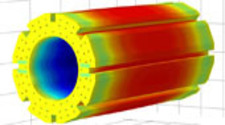
EDF Energy has received approval to start generating low carbon power again from its two Advanced Gas-cooled Reactors (AGRs) at Hunterston B power station in Ayrshire, Scotland. This follows a major, two-year inspection and investment programme to prove that the station can respond safely to a range of earthquake scenarios, far worse than the UK has experienced or are expected to occur.
Over time, the graphite bricks that form the AGR cores lose mass and can be subject to some distortion and cracking. Continued operation is based on regular safety cases. The safety cases are supported by inspections, modelling and projections of graphite, brick and core behaviour, which demonstrate that conditions remain within agreed safe limits with a very high degree of confidence. For over fifteen years, Quintessa has been providing support to EDF Energy to help support safety case arguments. This support has included:
- statistical modelling predicting and forecasting graphite and brick properties, including cracking;
- data-led multi-physics modelling and stress analysis of the graphite bricks; and
- the development of bespoke software to enable the optimisation of inspection strategies to manage and help analyse data from fuel grab load traces, and to help manage and visualise data from eddy current tools used to scan bricks during inspections.
Quintessa's support has included demonstration of understanding and forecasting of the expected cracking emanating from the keyways of graphite bricks that has been observed at the Hunterston B reactors (termed keyway root cracks) and which provide key metrics for continued safe operation.
